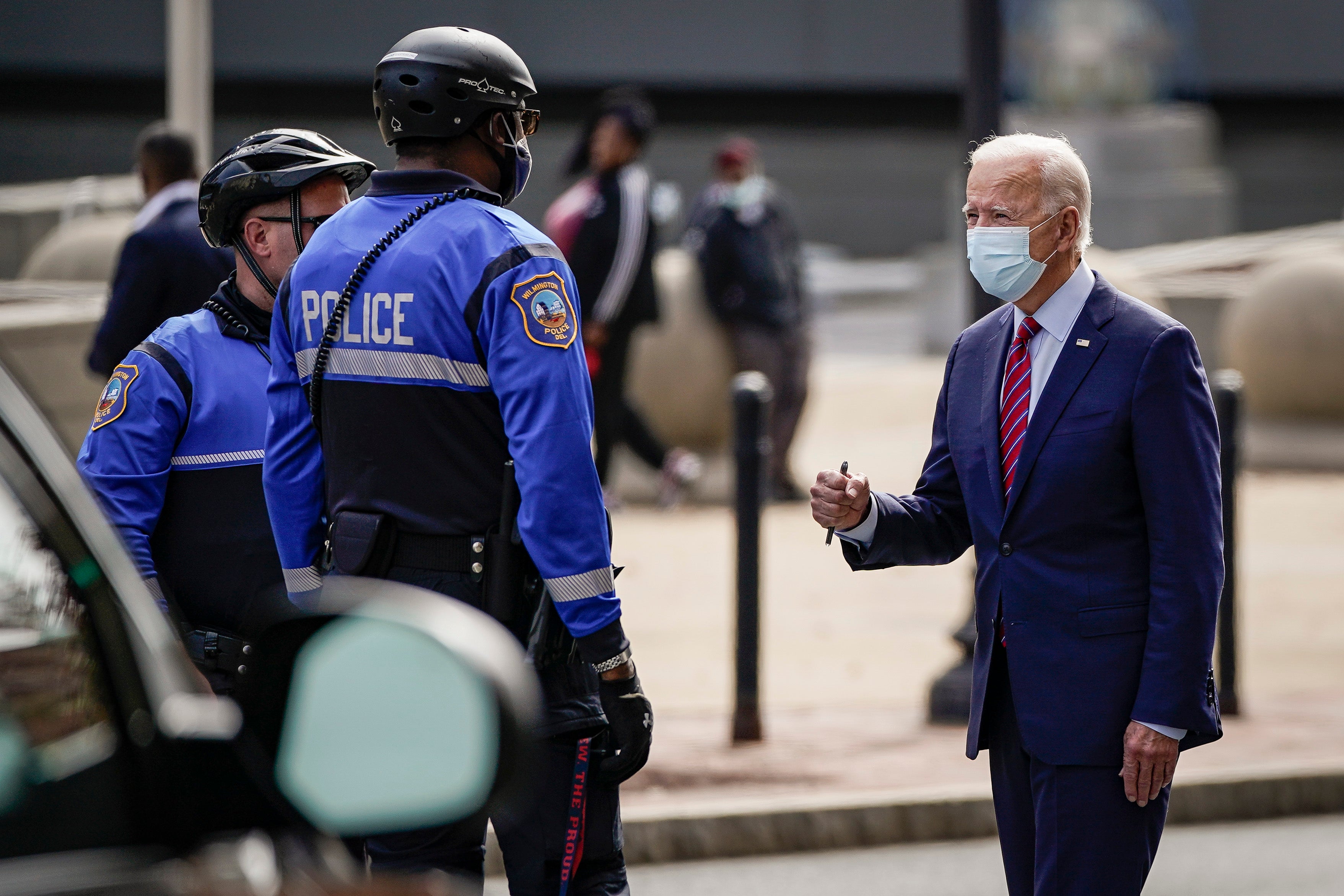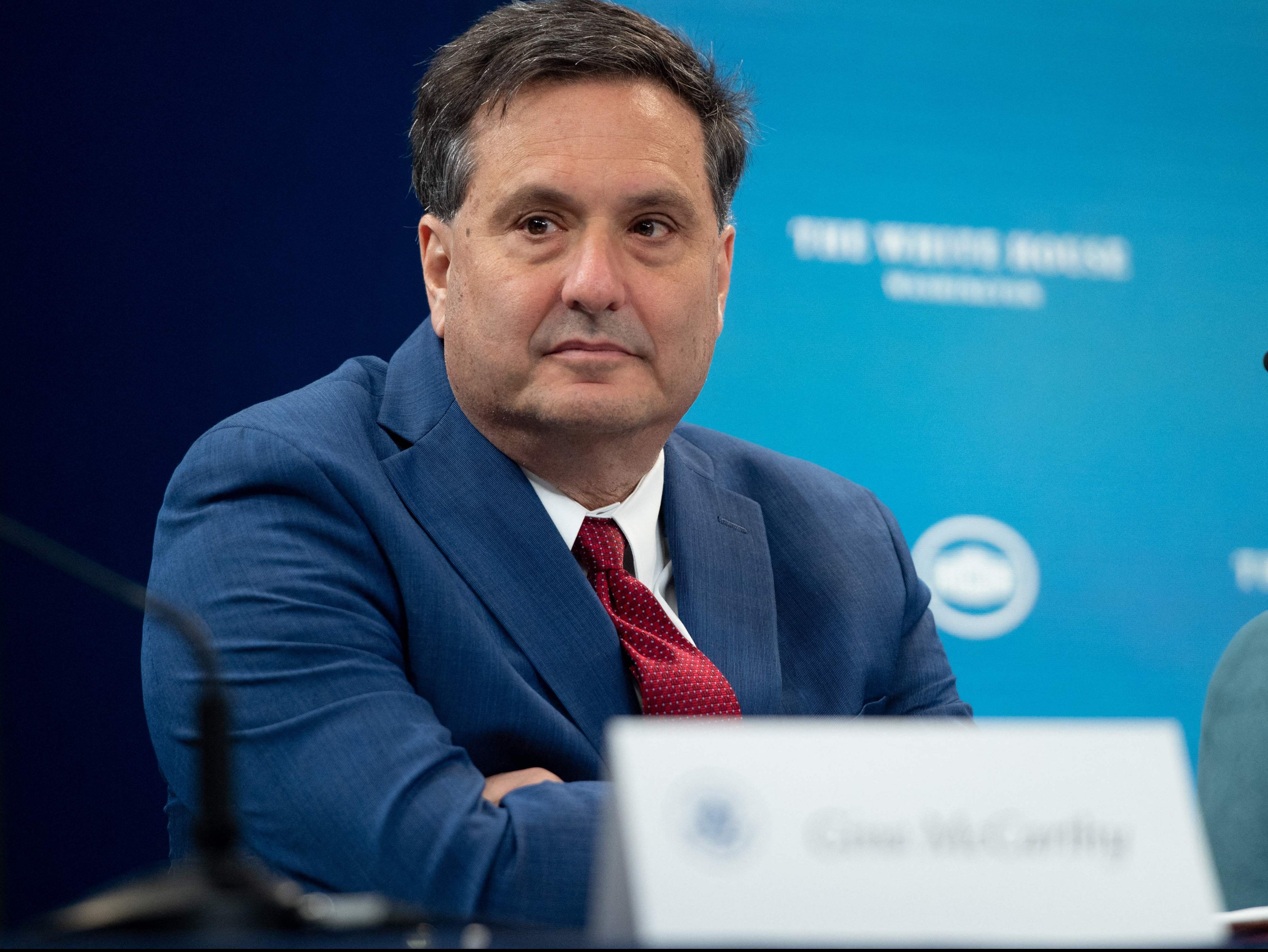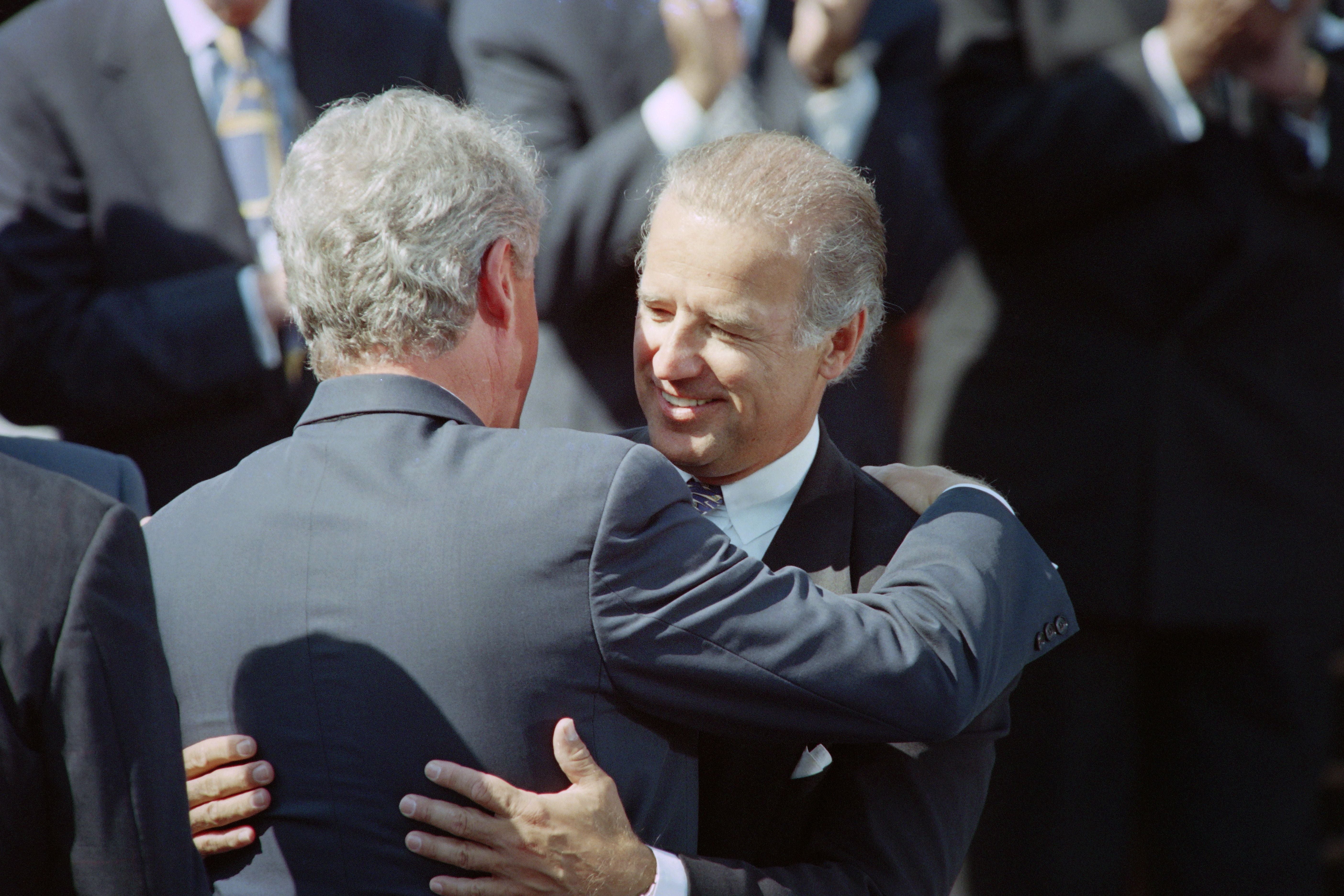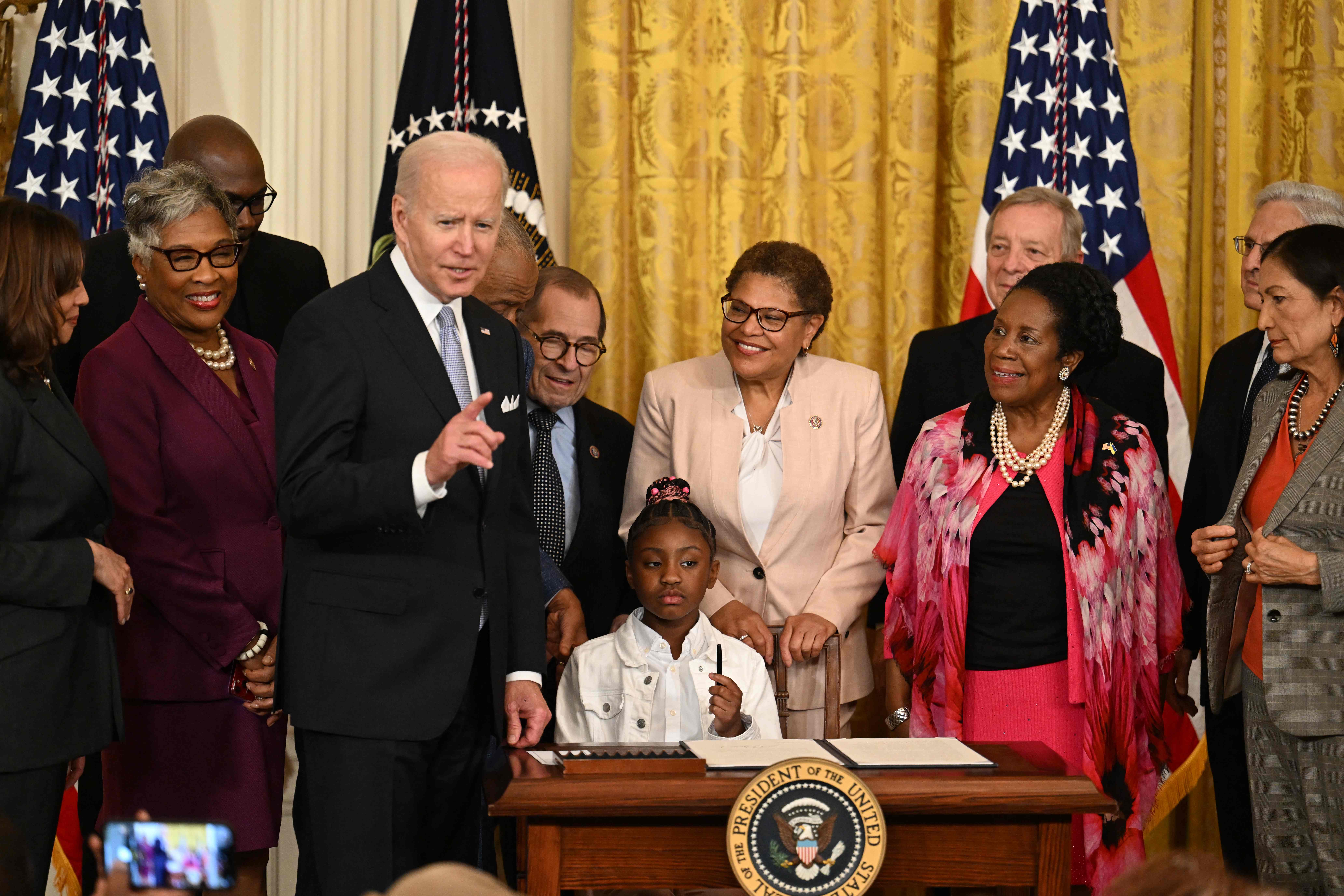Why does Biden want to hire 100,000 more police officers?
Advocates fear plan is repeat of 1994 crime bill, ‘one of the great mistakes this country has ever made’, Josh Marcus and Alex Woodward report


Your support helps us to tell the story
From reproductive rights to climate change to Big Tech, The Independent is on the ground when the story is developing. Whether it's investigating the financials of Elon Musk's pro-Trump PAC or producing our latest documentary, 'The A Word', which shines a light on the American women fighting for reproductive rights, we know how important it is to parse out the facts from the messaging.
At such a critical moment in US history, we need reporters on the ground. Your donation allows us to keep sending journalists to speak to both sides of the story.
The Independent is trusted by Americans across the entire political spectrum. And unlike many other quality news outlets, we choose not to lock Americans out of our reporting and analysis with paywalls. We believe quality journalism should be available to everyone, paid for by those who can afford it.
Your support makes all the difference.It’s 1994 again in Washington.
Americans are once again worried about rising crime rates. Democrats are once again worried that Republican attacks about them being “soft on crime” will cost them at the polls. And a backslapping, centrist Delaware legislator named Joe Biden is once again leading the charge to hire 100,000 new police officers, just as he did with his signature 1994 crime bill.
In 2022, the president is asking Congress to fund the $37bn Safer America Plan, which includes nearly $13bn to put 100,000 more police officers on the street.
“These funds will be used to get officers out of their stations and squad cars and into the community, walking the beat on foot patrols that have been shown to enhance officer morale, improve community relations, and have a deterrent effect on crime,” the White House said in a recently released breakdown of the plan.
As Mr Biden put it during his State of the Union address in March, “We should all agree the answer is not to defund the police. It’s to fund the police. Fund them with the resources and training they need to protect our communities.”
In the nearly three decades since the 1994 law, communities across the US have pushed for broader investments in public safety – housing, healthcare, jobs, education – while grappling with the impacts of mass incarceration and over-policing.
The White House appears to have caught up with those demands, making it all the more puzzling why it’s repeating a 30-year-old strategy in parallel.
"The president is right about the way to create safety for all communities is to have a greater investment in all of our systems," says Yasmin Cader, deputy legal director and director of the Trone Center for Justice and Equality at the American Civil Liberties Union.
However, she worries the White House has “cut and paste” some of the same policies that have fuelled America’s deeply unequal justice system.
“The war on drugs, and the scourge of mass incarceration was one of the greatest mistakes this country has ever made. It is irrational to sign up for that, again,” she tells The Independent. “No one wants to make that same mistake twice.”
The Safer America Plan is a Frankenstein bill, fusing together unlike parts into a massive whole.
Like the 1994 crime bill, it calls for more officers, and for harsher penalties for certain classes of drug crimes: fentanyl now, rather than the harsh clampdown against crack-cocaine in the ’90s, a punishment that disproportionately fell on communities of colour.
Unlike the 1994 plan, considered a key inflection point in America becoming the world leader in locking up its own citizens, the Biden crime agenda calls for even more non-carceral investment, including $5bn for community-based violence intervention programmes and another $15bn for grants that would go towards drug treatment diversion courts, mental health first responders, and other social-service focused policies.

While public safety advocates are encouraged to see a focus on community investment, people like the ACLU’s Cader are worried about red flags like the proposed enhancement of fentanyl sentencing, and the ambiguities about how the White House would make sure the 100,000 new officers it intends to support are accountable to communities and trained well, since policing is almost entirely under local control.
“How are we going to ensure that we’re not exacerbating harms, and we’re not failing to have systems of accountability?” Calder tells The Independent. “We haven’t heard anything about that. And so we need to make sure that we don’t just repeat the same mistakes, but that we actually learn from our history, and we learn from our experiences, and we listen to individual strategies on the ground, to be smart moving forward.”
The plan has few details on making sure the new officers would be effective, beside saying it would offer up new funds for police to conduct trainings, vaguely encourage police forces to follow the White House’s executive orders pertaining to federal law enforcement agents, and support programmes like bonuses and tuition reimbursement to help police forces attract “service-minded candidates” from under-represented backgrounds.
The magic number – 100,000 – is also echoed in the president’s proposal to fund 100,000 public health workers under his pitch for the American Rescue Plan.
White House Chief of Staff Ron Klain – among the architects of the 1994 crime bill under then-President Bill Clinton – came up with the 100,000 figure in that bill. (“I like to get a bunch of ideas and put them together and make it easier for people to understand and make it more compelling,” he told The Washington Post in 2015.)
The Clinton team reportedly had “no idea how many extra cops” to include in the crime bill at the time, and it was Mr Klain – now a key player shaping the Biden administration’s agenda – who asked, “Would 100,000 be enough?”

Jim Kessler, executive vice president for policy at the center-left think tank Third Way, worked for then-representative Chuck Schumer as he helped guide the 1994 crime bill through the House. He notes that the 1994 bill had broad bipartisan support — the Congressional Black Caucus, nearly the whole Senate, and 46 Republicans in the House backed the law — and thinks Mr Biden has hit on another public safety bill with broad appeal.
“He understands that it isn’t contradictory to be pro-police and also pro-police reform, and that people want safe streets, and they want a better police force, that concerns that people have, that folks like African-American communities and Black Lives Matter have, that they’re completely legitimate,” Kessler tells The Independent.
He agrees that “more cops alone won’t do it” and is glad to see the variety of community investments.
“It can make a big difference,” he says.
And none too soon.
Public safety is shaping up to be a defining political issue in races across the country in congressional midterms and beyond.
“Crime is the sleeper issue of this cycle,” Chris Hartline, communications director for the National Republican Senatorial Committee, told The Washington Post in June.
The National Republican Congressional Committee plans to put $52.3m behind adds that will in part attack Democrats on “soaring violent crime.”
Public safety was the crucial question in the fiery recall campaign against San Francisco District Attorney Chesa Boudin, and quality-of-life issues are propelling the campaign of Rick Caruso, a billionaire and former Republican running for mayor of Los Angeles as a Democrat.
White House officials said in July they hope Biden’s plan will show a “clear contrast” with the GOP, demonstrating how the Democrats “funded the police and taken action to fight crime while congressional Republicans have opposed these efforts at every turn”.
For people like Third Way’s Kessler, it’s a necessary correction in the national discourse. Republicans have spent years painting Democrats as ineffective on public safety issues, even though red America has been disproportionately feeling the effects of murder and gun violence in recent years.
“The politics of crime often works to the Republican party’s advantage when nothing gets done,” he says.
It lets the GOP claim Democrats have let things get out of control, he argues.
“Republicans have been winning the political battle on crime the last four or five years,” he says. “Crime is an important political issue. I think it really helped Republicans in the 2020 race. There needs to be more of the truth coming out about who is better at stopping crime.”
Public safety is not just a pressing concern for politicos either.
Earlier this year, a Gallup poll found that 72 per cent of people said they were dissatisfied with the country’s policies to reduce crime, the highest level this century, with majorities of Republicans and Democrats agreeing.
A 2021 Pew survey found that Black adults rate violence and crime as the single top issue facing their communities, with over five times more people ranking it above racism.
Within the debate surrounding Mr Biden’s approach to public safety is a deeper kind of argument: just what precisely the crime problem is, and what’s been the most effective way to fix it.
A deeper analysis of the data and history shows that mass incarceration began well before the 1994 crime bill, a policy which traded more officers and modest safety gains for an explosion in mass incarceration along racial lines.
Despite the tenor of politicians and some media stories, America is not descending into an unprecedented state of crime and chaos.
In 2020, the latest year for which comprehensive nationwide data is available, the murder rate rate rose by almost 30 per cent, but it’s still well below the high point of the last quarter century, the early 1990s. And killings plunged steadily between 1990 and 2014, only creeping back up in more recent years. Meanwhile, perhaps thanks to the Covid-19 pandemic, property crime actually fell to record lows in 2020.
And we’ve still got plenty of police. The rate of police officers per capita has been steadily increasing since the 1990s.
Even if things were spiraling out of control, it’s far from definitive whether a massive influx of officers would make a difference.
Scholarly consensus indicates that the massive funding of officers in the 1994 crime bill may have had some modest impact on crime rates, but that crime rates peaked in 1991, and were already falling before tens of thousands of new officers were deployed. Many experts believe other, non-related social factors like declining alcohol use and an aging population were just as influential.
Beyond funding more officers, the 1994 crime bill strengthened numerous drug penalties, instituted a federal “three strikes” rule causing mandatory life sentences for those with multiple convictions, rolled back the use of parole, encouraged more drug arrests, and devoted $12.5bn to the construction of new state prisons.

After the crime bill took effect, the imprisonment rate doubled between 1994 and 2009, though some of this can be explained by changes in state policy that mirrored or inspired tough on crime measures at the federal level. It was only in 2021 that the US finally returned to the incarceration rate of 1995.
“We got the wrong kind of police. Not the community police, just more police who weren’t sensitive to black and brown people. We got more prisons,” Rev Dr Vincent Oliver, a longtime civil rights activist and pastor from Wilmington, Delaware, told The New York Times.
The 1994 bill also furthered racial disparities in drug arrests, enforcing vastly higher penalties for crack cocaine, which was more prevalent in communities of colour, than its more expensive powdered form, used more often in white communities.
Experts worry that the Biden plan’s promise to “impose tough penalties on all forms of fentanyl” and boost police forces once again will repeat these drug war mistakes.
“What are we doing?” asks Kader of the ACLU. “We know that locking people up for drug-related crimes does not prevent drug-related crimes.”
“What works is addressing the underlying lack of opportunity and pain that exists because of our failure to invest for decades, in our people and in our communities.”
Unlike in 1994, the president can no longer rally both parties when it comes to public safety reform. Democrats are still pushing for more officers with more funding, but it seems that’s about all they can do in 2022.
In April 2021, Biden called on lawmakers to pass the George Floyd Justice in Policing Act by Memorial Day of that year, after Minneapolis police killed Floyd, whose death sparked international outrage and revived ugent demands to end police violence.
The US House of Representatives passed a version of the bill in March of last year without any Republican support on a vote of 220 to 212. A similar bill was passed in 2020 but languished in a then-GOP-controlled Senate.
A bipartisan working group – including Republican Senator Tim Scott, Democratic Senator Cory Booker and Democratic US Rep Karen Bass – led negotiations on a Senate version of the bill, which aimed to change the threshold for permitting police to use force, outlaw police chokeholds at the federal level, ban no-knock warrants in federal drug cases, and create a national registry of police misconduct cases under the auspices of the US Department of Justice, among other reforms.
But Republicans and law enforcement lobbyists balked at a key element of the proposal to reform provisions around qualified immunity, a decades-old doctrine that grants law enforcement broad protections from criminal liability. Republicans have argued that weakening those protections could expose police officers and agencies to excessive lawsuits.
A compromise bill offered up by Republicans would retain immunity provisions for individual officers and instead allow victims or people alleging police misconduct to sue their police departments. By September, months after the president’s deadline, the negotiations fizzled out without any apparent plans to revive the effort at a later date.
“After months of exhausting every possible pathway to a bipartisan deal, it remains out of reach right now,” Senator Booker said in a statement at the time
Despite support from powerful police unions like the Fraternal Order of Police and International Association of Chiefs of Police, “there was still too wide a gulf with our negotiating partners and we faced significant obstacles to securing a bipartisan deal,” Mr Booker said.

Two years after Floyd’s murder, the president instead signed an executive order – what the White House promised would be the “most significant police reform in decades” – alongside members of Floyd’s family as well as the family of Breonna Taylor, who was killed by police in her home in Louisville, Kentucky in March 2020.
But the measure is more narrowly tailored around federal agencies, not local cops. It directs federal agencies to address their use-of-force and no-knock warrant policies – mandating that federal law enforcement adopt standards must “meet or exceed” ones already in place with the Justice Department. The measure also aims to build a new national database for reporting police misconduct – but state and local offices are merely “encouraged to enter their records”. It’s unclear whether there will be a way for the public to gain access.
The gun safety bill Mr Biden signed in June, for instance, doubles funding for school police and other school security measures, investing $300m more in federal anti-violence grants, even though so-called school resource officers have been shown to disproportionately arrest Black students and do next to nothing to stop gun violence on campus.
Police reform, in other words, is all but dead in the water in DC, even as funding for officers remains on the table politically. Now, it’s up to Congress to decide what other parts of America’s controversial criminal justice past to resurrect for Joe Biden, and which to leave behind.



Join our commenting forum
Join thought-provoking conversations, follow other Independent readers and see their replies
Comments